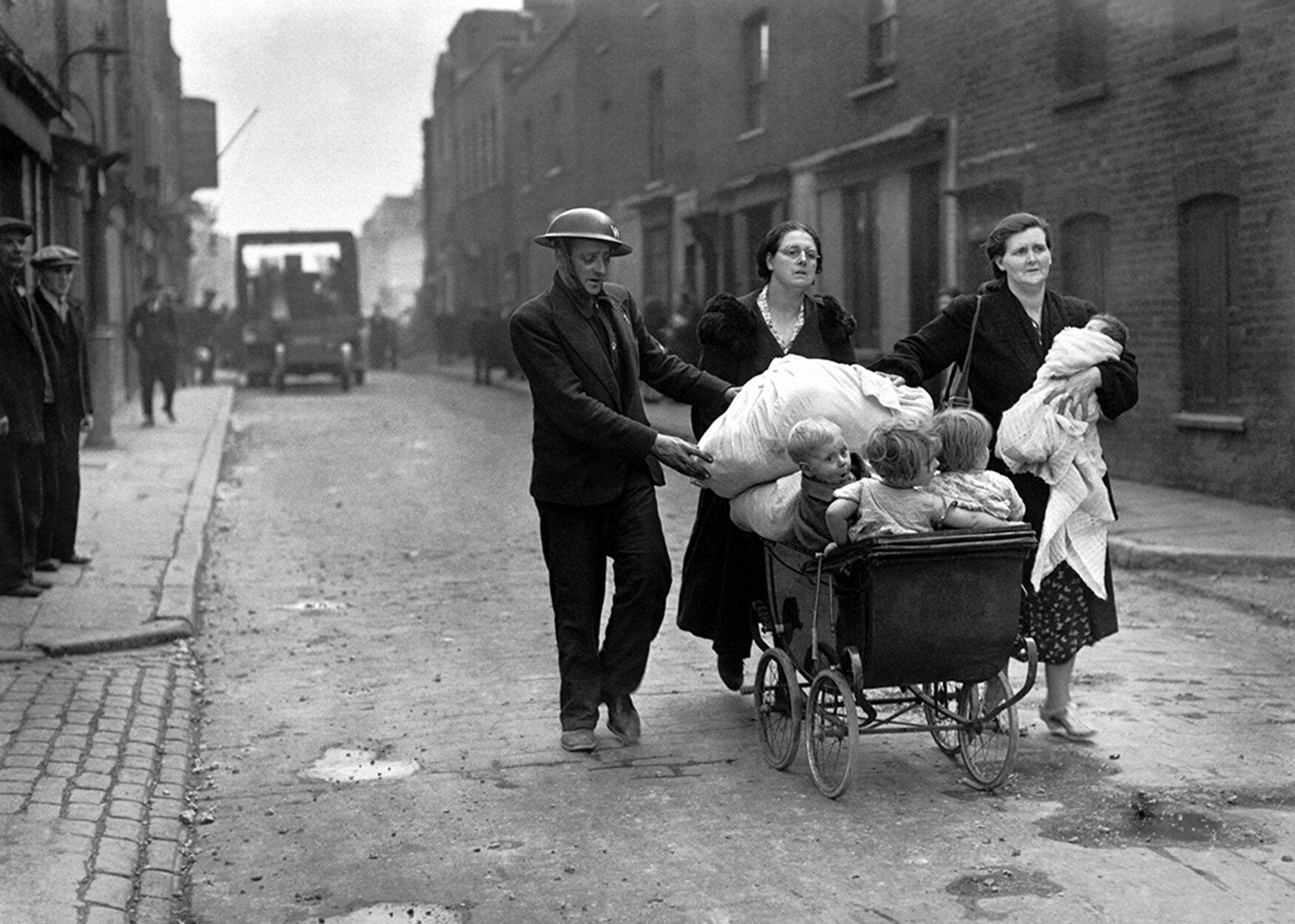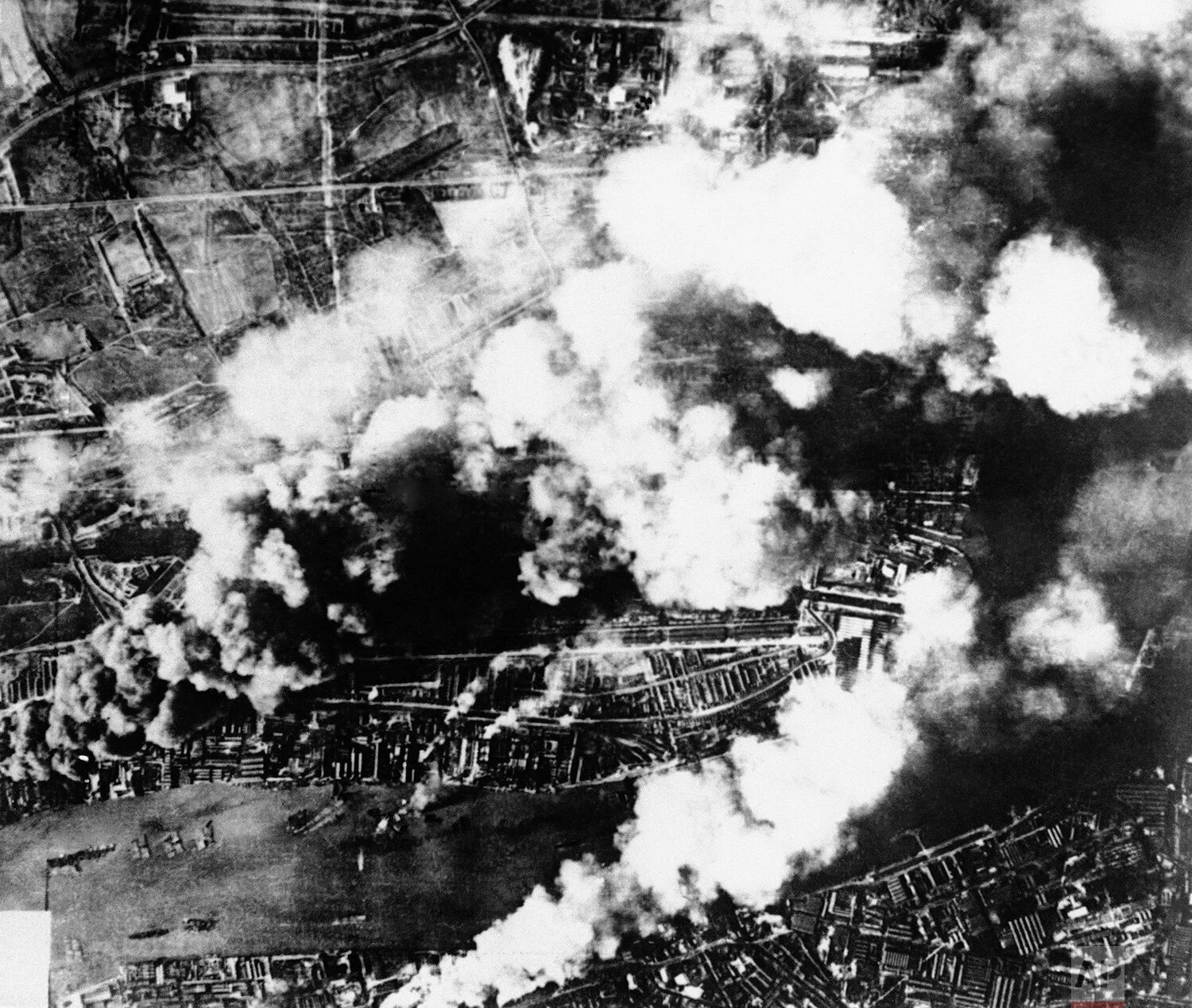The Battle of Britain and the Blitz

From July 10 to October 31, 1940, the Battle of Britain raged in the air as the Royal Air Force defended Britain from relentless attacks by the Luftwaffe (Nazi Germany’s air force) during World War II. In an effort to force Britain to sign a negotiated peace, the Nazi attacks continued through that year, culminating in nighttime bombings of London, known as the Blitz.
Hurricane formation above the lower cloud layers patrol in an aerial wonderland, on Nov. 27, 1940. These fighters can fly at a height of more than six miles. (AP Photo)
Observers of bomber crews receive final instructions from their navigation officer (centre) before setting out to bomb military objectives in Germany’s forest, somewhere in England on Sept. 5, 1940. (AP Photo)
Above two Spitfires appear three more of these trim military fighters, off to repel enemy planes, whose approach was heralded by air-raid warnings Jan. 24, 1940. The Spitfires are among aviation’s fastest military machines. (AP Photo)
“The odds were great, our margins small; the stakes infinite.”
Winston Churchill
Winston Churchill is pictured in London, England, on March 28, 1940. On June 17, 1940, as German forces marched across continental Europe and the United States was still holding back from the growing conflict, the new British prime minister, summoned his nation to battle Adolf Hitler. (AP Photo)
British workers in a salvage yard, August 26, 1940, breaking up the remains of wrecked German raiders which were shot down over England. This view was taken through the fuselage of a German plane. (AP Photo)
Queen Elizabeth did not have far to go, to find an anti-aircraft unit ready to turn on the heat for Nazi raiders. This Scottish unit visited by her majesty was in one of London’s Parks, August 7, 1940. (AP Photo)
“On November 14 some 500 Nazi planes converged on Coventry, northwest of London. They blasted motor factories – along with churches, hospitals and schools - and left the city virtually in ruins. A power shovel dug a trench to bury 200 dead in one grave.”
Residents of Coventry walk through the streets amidst damage and destruction caused by a major bomb raid by the Germans on Nov. 14 in Coventry, England in 1940 during World War II. (AP Photo)
Coventry Cathedral, one of the finest examples of 14th Century Ecclesiastic architecture, lays in ruins after a German air raid on Nov. 14 during World War II in 1940. (AP Photo)
A general view of mass burial service in Coventry, England, Dec. 9, 1940, for persons killed in the air raid on November 14. (AP Photo)
The Blitz, Hitler's attempt to demoralize the English people through concentrated bombing of population centers, particularly London, and industrial facilities, began on the night of September 7, 1940, and lasted until May 11 the next year.
The effects of the first big concerted attack of the German air force, Sept. 7, 1940 in London dock and industry districts. Factories and storehouses were seriously damaged. (AP Photo)
A housewife and her baby bring her contribution of pots and pans in a pram to Chelsea Town Hall, London, Oct. 7, 1940 after Lord Beaverbrook made an appeal to the women of Britain to give their aluminum pot and pans to be converted into Spitfires and Hurricanes. (AP Photo)
Aluminium pans, frying pans and kettles for melting down in a huge pile at the sorting depot ready for smelting, somewhere in England on Sept. 17, 1940. The metal is used to build new fighter planes for the Royal Air Force. (AP Photo)
Out of the frying-pan and into the Spitfire. Housewives who have sent all their aluminum saucepans from all over Great Britain to the salvage depots for melting down into parts for airplanes, doubtless wonder how this miracle is performed. The process through which the old pot must go to become the new plane. The old saucepans being ladled into the smelting pot, Sept. 17, 1940, where they will be reduced to a liquid. (AP Photo)
An East London family moves to safer quarters on September 8, 1940 after losing their home on the opening night of the Blitz. (AP Photo)
Mr. Harold Edward Reeves of Essex was rescued after he had been trapped for 16 hours in his car in the basement of a bomb-wrecked central London garage, Sept. 18, 1940. The first thing he said to the waiting cameraman was “Do you want a smile?” The rescue party had been working unceasingly oblivious of air raid warnings to remove him from under 20 feet of wreckage. Mr. Reeves smiles for the camera as he is at last carried away on a stretcher from his 16 hours prison. (AP Photo)
St. Paul's Cathedral in London survives another Blitz by Nazi Germany, 1940 or 41. (AP Photo)
A London bus which took a nose-dive into a bomb crater is seen standing on end in the hole, in London on Oct. 15, 1940, after a Nazi air raid. (AP Photo)
Reading history and seeing it, too an amusing sidelight of the latest chapter in London’s history is this lad who, according to the British caption, sits mid the ruins of a London bookshop following an air raid on Oct. 8, 1940 in London, reading the “History of London.” (AP Photo)
“A million went underground to sleep in subway stations and stairways. They emerged in daylight to dig out the dead and watch flames roaring through the streets. For days on end the skies were black with smoke above London, Bristol, Birmingham, Liverpool, Manchester, Sheffield and scores of other places. “
Londoners sleep on stopped escalators of a tube station for safety and shelter during heavy bombing by the Germans in London, England, in 1940 during the Blitz in World War II. (AP Photo)
A London family shows how one of the small Anderson shelters can be used as a family dwelling during long air raid alarms in London, Oct. 19, 1940. British caption says the idea of equipping the shelters with bunks belongs to a London policeman. This shelter is capable of holding bunks for four adults and four children. (AP Photo)
“On December 29 a record incendiary attack was made on London. It wrecked a square mile area in the city proper, including many landmarks, and started the greatest fire the city had known since the blaze of 1666. “
The huge crater made by a bomb which fell immediately outside the front door of the Associated Press building in Tudor Street, London during a raid when a neighboring house was demolished, Sept. 26, 1940. In the picture are seen some members of the staff of the Associated Press who were busy though the night clearing up the bomb damage. (AP Photo/Eddie Worth)
AP’s London bureau was struck twice during the Blitz. The second attack on December 30, 1940, destroyed AP’s Tudor Street bureau. Flames destroyed the top of the building and water damaged the rest. AP quickly re-located to the newsroom of the Press Association; no staff were injured.
Quotes from “A History of World War II” , an Associated Press publication by John L. Springer, distributed in 1945. Additional text by Francesca Pitaro.





















